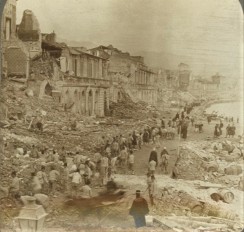The first earthquake risk model for the whole of Europe shows the cities and regions most threatened by disaster

Scientists have created the first earthquake risk model for Europe which will form the basis for mitigation measures and will make communities more resilient to the impact of natural disasters.
Earthquakes have been responsible for more than 200,000 deaths - as well as €250 billions in damage - in Europe during the 20thcentury.
Because it can’t be accurately predicted when and where an earthquake can happen in the future, areas at particular risk need to construct homes and buildings that can withstand earthquakes without undertake too much damage.
European seismologists, geologists, and engineers have revised the existing earthquake hazard model for Europe that was first published in 2013, and have also created an earthquake risk model for the whole continent for the first time.
Earthquake hazard
The earthquake hazard describes potential ground shaking due to future earthquakes and is based on knowledge about past earthquakes, geology, tectonics, and local site conditions at any given location across Europe.
The team, led by members from the Swiss Seismological Service and the Group of Seismology and Geodynamics at ETH Zurich, says that with an updated data set for the hazard model, they have a more accurate results for all parts of Europe.
Their model confirms Turkey, Greece, Albania, Italy, and Romania are the countries with the highest earthquake hazard in Europe, followed by the other Balkan countries.
First European earthquake risk model
The earthquake risk refers to the estimated economic and humanitarian cost of potential earthquakes.
With this information mapped out, the scientists believe that decision-makers have a new valuable tool available to build more resilient communities, constructing and designing buildings that can withstand the risks of earthquakes.
The model “provides authoritative information to inform national authorities related to developing seismic design codes and risk mitigation strategies”, the team states. They also point out the main drivers of earthquake risk are older buildings.
Turkey, Italy, Romania and Greece experience 80% of the modelled average annual economic loss from earthquakes in Europe, which accounts for €7 billion.
On the contrary, cities including Zagreb (Croatia), Tirana (Albania), Sofia (Bulgaria), Lisbon (Portugal), Brussels (Belgium), and Basel (Switzerland) also have an above-average level of earthquake risk.
Sources: euronews.com, ethz.ch
Image Gallery
Want to read more like this story?
Earthquake Engineering
Jan, 01, 2019 | EducationEarthquake engineering is a critical field of civil engineering that focuses on the analysis, desi...

Messina earthquake (1908): a civil engineering landmark
May, 26, 2023 | EducationThe 1908 Messina earthquake, also known as the Great Reggio earthquake, is considered as one of t...

5.8-magnitude earthquake strikes Ecuador coast: damaged buildings, huge loss of property, no tsunami
Mar, 28, 2022 | NewsA huge loss of property was suffered when an earthquake of magnitude 5.8 struck Ecuador coast on Sa...

Greece and Italy: an earthquake early warning system could save lives
Feb, 08, 2022 | NewsA public earthquake early warning system in Greece and Italy could give people vital seconds’ notic...

New study claims that surface hazards, e.g. landslides, can cause earthquakes
Jun, 20, 2024 | NewsA new study conducted by the Swiss Federal Institute for Forest, Snow and Landscape Research (WSL)...

Earthquakes: five deadliest earthquakes ever recorded around the world
Feb, 24, 2022 | NewsEarthquakes are one of the most dangerous natural disasters. More than 100 earthquakes of the magni...

Iran: 425 earthquakes struck in one month
Mar, 13, 2024 | NewsAccording to the seismological networks of the Institute of Geophysics at the University of Tehran,...

Updated National Seismic Hazard Model in the United States
Jan, 26, 2024 | NewsA group, led by the U.S. Geological Survey, presented the most recent version of the National Seism...

The five strongest earthquakes ever recorded
Sep, 09, 2023 | NewsThe following lines describe five of the most devastating earthquakes in history: The Great Chile...
Trending

Spectacular interchanges around the world

New Release - STAAD.Pro 2024 - 2

ADINA 2025 for Structural WorkSuite

ADINA 2025 New Release!

Concrete Buildings as Rechargeable Batteries

Powerful earthquake shakes central Philippines, dozens killed




